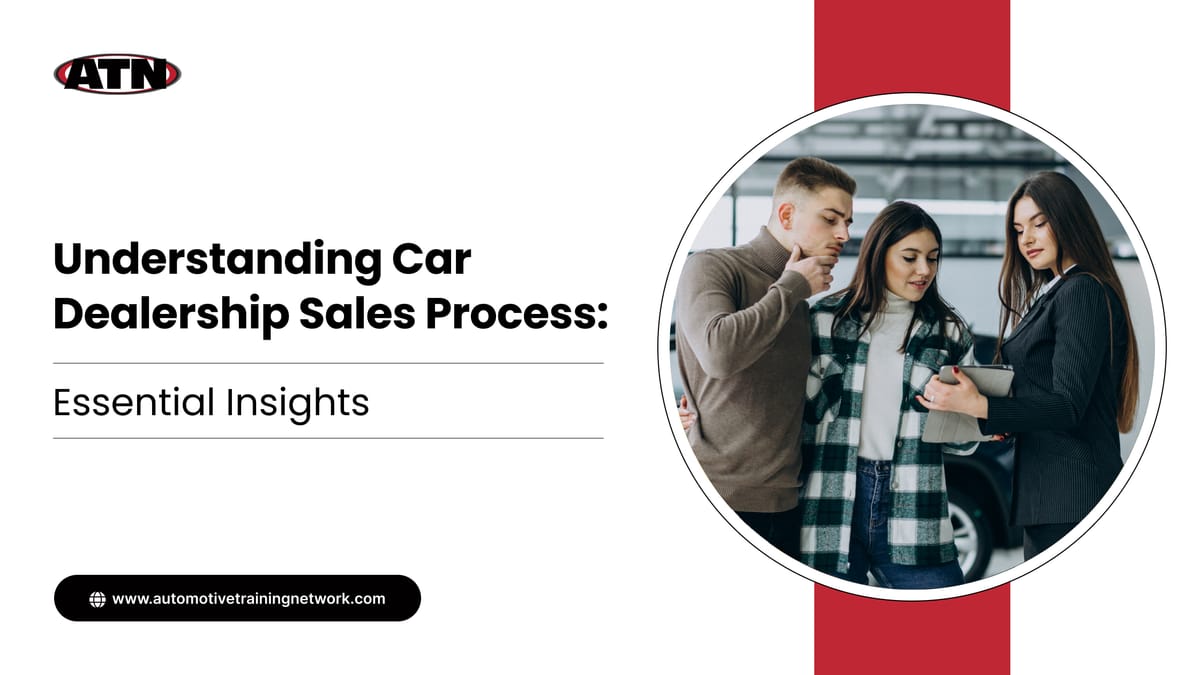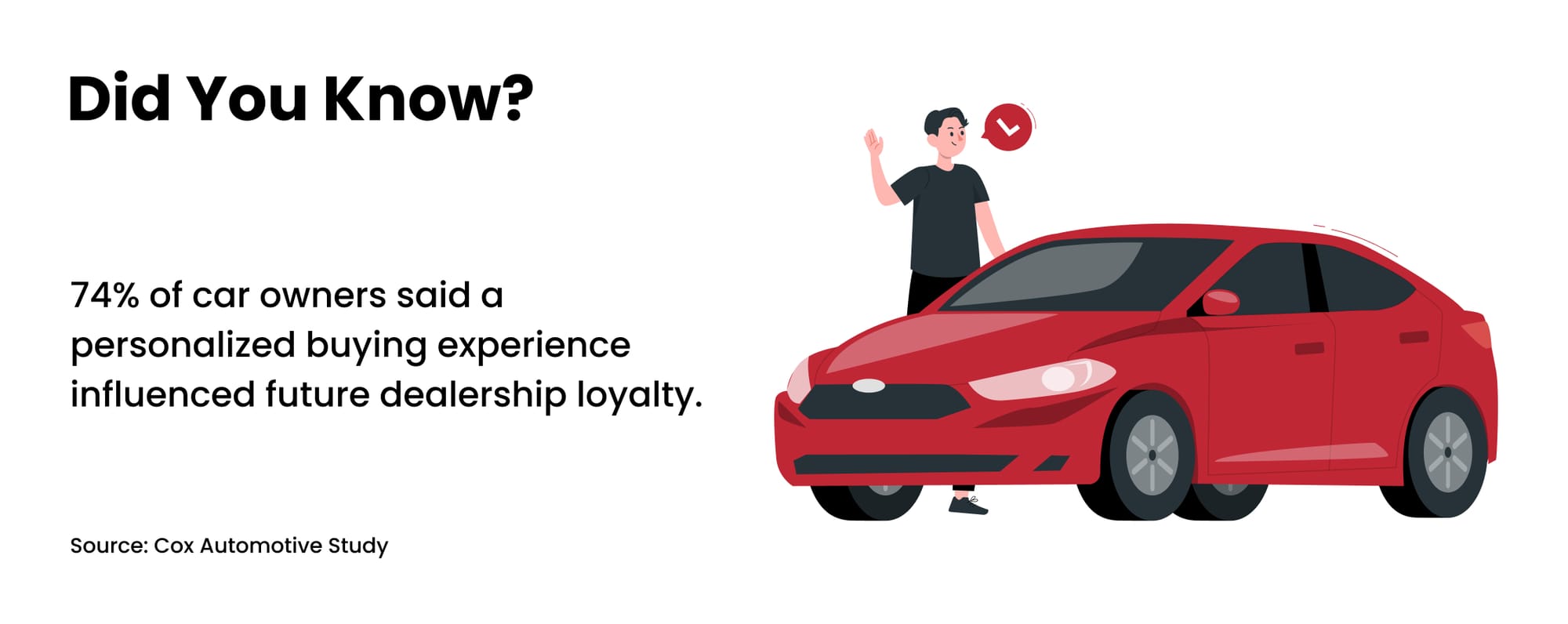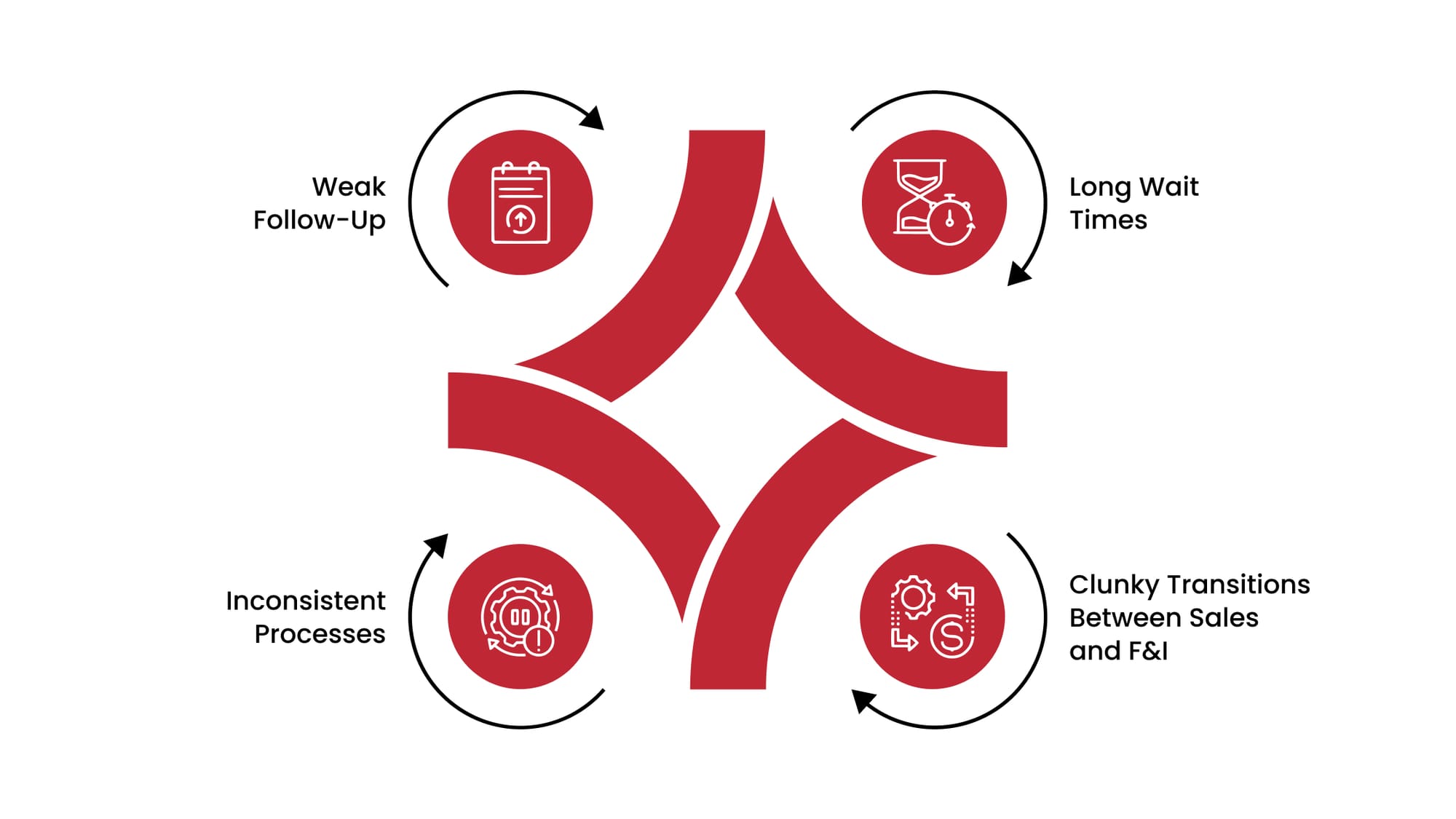Understanding Car Dealership Sales Process: Essential Insights

Research shows that 90% of car buyers go online before visiting a dealership, yet more than half still choose to complete the purchase in person. If your car dealership’s sales process isn’t prepared to deliver on both fronts, you risk losing more than half of your potential customers.
Margins are tightening, expectations are climbing, and buyers walk in already knowing the specs, the price, and the options. But surprisingly, satisfaction plunges after test drives, with only 56% of buyers rating the finance stage positively.
So, what went wrong?
Is your dealership not knowledgeable enough?
Are your products falling short?
Is your team not putting in the effort?
Are customers simply impossible to please?
Not at all. The real issue is the sales process. Outdated or inconsistent steps leave customers frustrated, walking out, or disengaged. By understanding and refining the sales process, dealerships can transform buyer journeys from stressful to seamless, while boosting conversion and profitability.
In this blog, we will discuss the primary stages of the car dealership sales process, customer expectations at each stage, and how you can adapt to close more deals.
Why Does the Sales Process Still Matter in the Automotive Industry?
A lot has changed in automotive retail. Buyers arrive more informed, often knowing the exact make, model, and trim they want before they set foot in the dealership. Some even walk in with financing pre-approved.
So why does the process still matter? Because information alone doesn’t close deals, experience does.
A structured sales process helps dealerships:
- Build trust in the first few minutes.
- Deliver personalized experiences instead of one-size-fits-all pitches.
- Control the pace and flow of the interaction.
- Reduce friction at common frustration points like F&I.
- Keep customer satisfaction high from start to finish.
Dealerships that formalize their sales process and train staff to execute consistently outperform those that rely on “winging it.” ATN has seen firsthand that dealerships adopting a structured car dealership sales process achieve higher conversions and fewer walk-outs, as outlined in ATN’s defined automotive sales process.
Customers want control, speed, transparency, and reassurance. When dealerships provide those, conversion rates climb.
Essential Stages of the Dealership Sales Process

1. Meet & Greet
The first five minutes define the entire interaction. Buyers who feel pressured at the start are far more likely to leave. A strong meet & greet sets a welcoming tone, shows genuine interest, and earns trust.
Pro Tip: Use openers that acknowledge their research: “I see you’ve been comparing SUVs online. What stood out to you?”
Mistake to Avoid: Jumping straight to “What can I get you into today?” feels transactional, not relational.
2. Discovery
Discovery is about listening more than talking. This step shows why the buyer is there, such as their first car, a family upgrade, or a luxury experience, and what factors (trade-ins, financing, lifestyle) shape their decision.
Pro Tip: Ask layered car sales questions to customers like: “What matters more to you, monthly payment flexibility or total purchase price?”
Ask layered questions: “What matters more to you, monthly payment flexibility or total purchase price?”
Mistake to Avoid: Skipping discovery just because someone looks “ready to buy.” Even informed buyers value being understood.
3. Vehicle Walk-Around
This is where product knowledge meets customer needs. A family may want safety features, an enthusiast wants performance, and a commuter wants fuel efficiency. Tie the car’s story to their story.

Best Practice: Don’t overload with specs. Highlight three features that directly meet the buyer’s priorities.
4. Test Drive
The test drive is the emotional core of the process. Customers picture themselves owning the car here, so it shouldn’t be rushed or generic. Do not talk too much. Allow silence so the buyer can feel the drive without distraction.
Pro Tip: Choose a route with mixed conditions, city streets, highways, turns, that mirrors real use.
5. Post-Drive Review
Immediately after the drive, emotions are high and decisions are forming. This is the best time to anchor positives and address doubts.
Pro Tip: Ask direct but open questions: “What did you enjoy most? What felt different from your current car?”
Mistake to Avoid: Skipping this reflection and heading straight into numbers.
6. Service Introduction
Buyers want to know they’ll be supported after purchase. Introducing your service department early signals a long-term partnership, not just a transaction.
Recommended Approach: Walk them through your service lounge, introduce a service advisor, and highlight perks like loaner cars or express service.
Common Pitfall: Treating service as an afterthought, only mentioned during delivery.
7. Presenting the Numbers
This stage makes or breaks trust. Transparency is non-negotiable. Hidden fees or vague math are the fastest path to walk-outs.
Pro Tip: Use clear worksheets with line-by-line breakdowns and explain why costs exist.
Sample Deal Worksheet
Monthly Payment Estimate (60 mo. @ 6.5%) → $527
This type of worksheet builds trust because everything is transparent: base price, deductions, taxes, fees, and add-ons. No surprises.
8. Negotiation & Closing
Closing is about problem-solving while dealing with pressure. A skilled sales team builds confidence by listening, addressing objections with empathy, and reinforcing decisions with data. Customers want clarity and reassurance, not ultimatums.
Do’s
- Recognize buying signals early (questions about warranty, payments, or delivery).
- Use data, such as trade-in values or financing scenarios, to support decisions.
- Keep the tone collaborative, positioning the deal as a win-win.
- Summarize agreements clearly to reduce uncertainty.
Don’ts
- Don’t force “now or never” deadlines that create distrust.
- Don’t oversell. Closing should feel natural, not staged.
- Don’t ignore silent hesitations; ask open questions to uncover concerns.
- Don’t make promises you can’t keep just to secure the signature.
Car sales negotiation tips like these ensure your team closes confidently without creating pressure.
9. Finance & Insurance (F&I)
F&I consistently receives the lowest satisfaction ratings due to delays, paperwork, and aggressive upselling.
Pro Tip: Streamline with digital signatures, pre-filled forms, and clear options explained in advance.
Best Practice: Position F&I products as protection, not extras. E.g., “This warranty protects your investment” vs. “Do you want to add this on?”
Mistake to Avoid: Springing unexpected costs at the last minute.
10. Delivery
Delivery is the buyer’s first actual memory of ownership. Make it feel special. A sloppy handover can undo weeks of trust-building, while a thoughtful delivery experience cements loyalty and excitement.
Ideas to Elevate the Delivery Experience
- Feature Walkthrough: Take time to explain major features (Bluetooth setup, safety systems, drive modes).
- Service Intro: Reintroduce the service team, reinforcing long-term support.
- Personal Touch: Add a handwritten thank-you note or a branded gift (keychain, water bottle, or accessories).
- Photo Moment: Stage a celebratory photo or short video of the handover, something customers want to share online.
- Digital Setup: Help pair their phone, set up navigation, and connect apps so the car is entirely “theirs” before leaving.
- Follow-Up Schedule: Book their first service appointment on the spot, removing future friction.
- Memorable Send-Off: A simple gesture like unveiling the car or a team clap creates a lasting impression.
Don’t: Rush through paperwork, skip feature demos, or treat delivery as the finish line. It’s the beginning of the ownership journey.
11. Follow-Up
Follow-up is where loyalty and referrals begin. One thank-you call is not enough. This is your chance to stay relevant beyond the sale.
Pro Tip: Schedule personalized check-ins, service reminders, birthday wishes, and anniversary notes tied to their purchase. Use CRM software to ensure consistency without sounding robotic.
Mistake to Avoid: Generic bulk emails that feel impersonal.
12. Referrals
Satisfied customers are your best salesforce. A structured referral program turns goodwill into steady leads.
Pro Tip: Offer small but meaningful rewards like service credits, free accessories, or VIP treatment for successful referrals.
Best Practice: Ask for referrals when excitement is highest, during delivery, or right after a positive follow-up.
Mistake to Avoid: Treating referrals as optional. Consistent asks build consistent results.
Common Breakdown Points in Dealership Operations

Even strong dealerships stumble on a few recurring issues that directly impact customer satisfaction and long-term profitability.
Long Wait Times
Customers today expect speed. Most walk into the dealership after already doing hours of online research, so sitting for 30–45 minutes before anything happens feels like wasted time. Long waits create frustration and set the wrong tone for the entire interaction, making customers less receptive when the actual deal discussion begins.
Clunky Transitions Between Sales and F&I
The handoff from the salesperson to the finance manager is one of the most critical moments in the journey. When that transition feels abrupt or disorganized, such as repeating questions, losing documents, or awkward silences, customers lose confidence.
A smooth, well-scripted handoff communicates professionalism and keeps the buying momentum alive.
Inconsistent Processes
Customers notice when one person explains the process thoroughly while another skips steps. Skipping a walk-around or failing to highlight features they care about makes buyers feel undervalued.
Inconsistency across teams creates an impression that the dealership lacks organizational cohesion, which directly impacts trust and CSI scores.
Weak Follow-Up
The sales cycle shouldn’t end at delivery. Yet, many dealers fail to check in after the sale. Without a proper follow-up, customers are less likely to return for service, referrals, or their next vehicle purchase. A single missed call or email can cost not just a repeat buyer but an entire lifetime of revenue.
With consistent dealership training, these pitfalls can be turned into strengths. Clear processes, structured handoffs, and disciplined follow-up ensure every customer touchpoint builds confidence, loyalty, and repeat business.
Drive Higher Conversions and Loyalty with ATN’s Dealership Training

A high-performing sales team is built through consistent, structured training. That’s precisely what the Automotive Training Network (ATN) delivers. With 40 years of experience, ATN equips dealerships with proven strategies that drive higher conversions, stronger customer loyalty, and lasting profitability.
ATN offers flexible programs to fit your dealership’s needs, including:
- Sales Training
- Virtual Training
- Customized In-Dealership Programs
- Intensive BDC Boot Camps
- Finance Training
When your team knows how to build authentic relationships, present with confidence, and close deals effectively, your dealership wins.
Ready to turn missed opportunities into sales growth? Partner with ATN and start training your team for peak performance.
